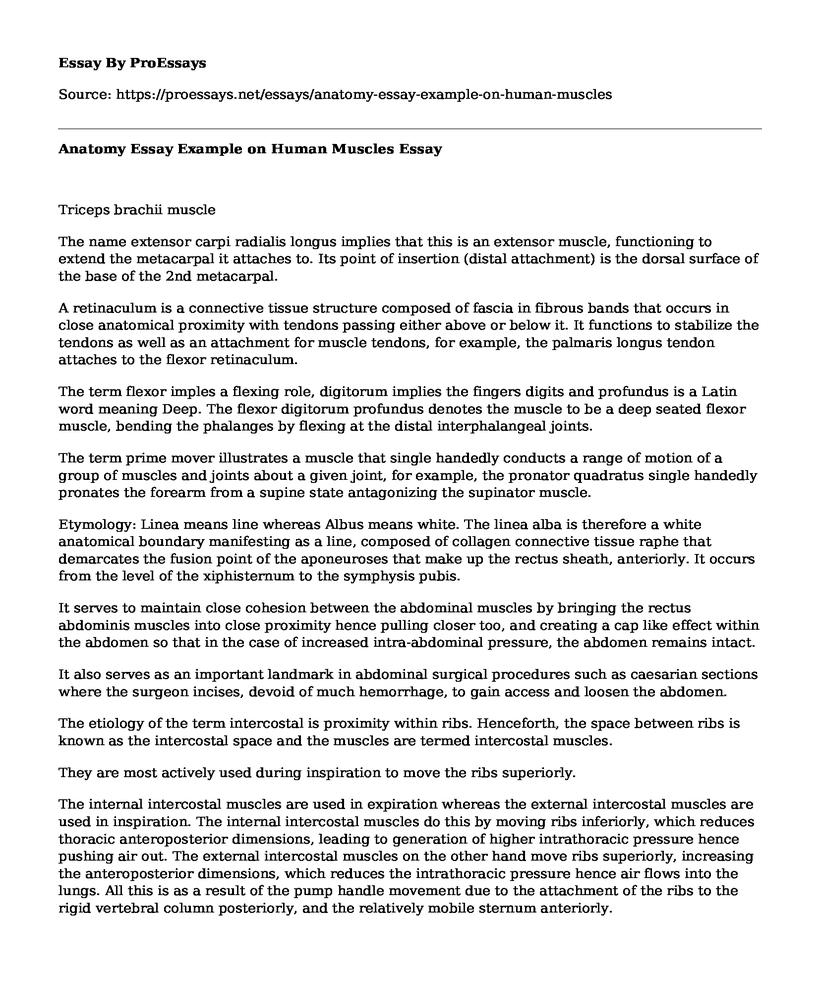Triceps brachii muscle
The name extensor carpi radialis longus implies that this is an extensor muscle, functioning to extend the metacarpal it attaches to. Its point of insertion (distal attachment) is the dorsal surface of the base of the 2nd metacarpal.
A retinaculum is a connective tissue structure composed of fascia in fibrous bands that occurs in close anatomical proximity with tendons passing either above or below it. It functions to stabilize the tendons as well as an attachment for muscle tendons, for example, the palmaris longus tendon attaches to the flexor retinaculum.
The term flexor imples a flexing role, digitorum implies the fingers digits and profundus is a Latin word meaning Deep. The flexor digitorum profundus denotes the muscle to be a deep seated flexor muscle, bending the phalanges by flexing at the distal interphalangeal joints.
The term prime mover illustrates a muscle that single handedly conducts a range of motion of a group of muscles and joints about a given joint, for example, the pronator quadratus single handedly pronates the forearm from a supine state antagonizing the supinator muscle.
Etymology: Linea means line whereas Albus means white. The linea alba is therefore a white anatomical boundary manifesting as a line, composed of collagen connective tissue raphe that demarcates the fusion point of the aponeuroses that make up the rectus sheath, anteriorly. It occurs from the level of the xiphisternum to the symphysis pubis.
It serves to maintain close cohesion between the abdominal muscles by bringing the rectus abdominis muscles into close proximity hence pulling closer too, and creating a cap like effect within the abdomen so that in the case of increased intra-abdominal pressure, the abdomen remains intact.
It also serves as an important landmark in abdominal surgical procedures such as caesarian sections where the surgeon incises, devoid of much hemorrhage, to gain access and loosen the abdomen.
The etiology of the term intercostal is proximity within ribs. Henceforth, the space between ribs is known as the intercostal space and the muscles are termed intercostal muscles.
They are most actively used during inspiration to move the ribs superiorly.
The internal intercostal muscles are used in expiration whereas the external intercostal muscles are used in inspiration. The internal intercostal muscles do this by moving ribs inferiorly, which reduces thoracic anteroposterior dimensions, leading to generation of higher intrathoracic pressure hence pushing air out. The external intercostal muscles on the other hand move ribs superiorly, increasing the anteroposterior dimensions, which reduces the intrathoracic pressure hence air flows into the lungs. All this is as a result of the pump handle movement due to the attachment of the ribs to the rigid vertebral column posteriorly, and the relatively mobile sternum anteriorly.
PROVIDE IMAGE
These muscles are involved mostly in the flexion of the thigh at the hip joint.
It flexes the thigh at the hip joint. It is also an adductor muscle at the hip joint.
Vastus medialis
Vastus intermedius
Vastus lateralis
Rectus femoris
It is an inverted triangle, bordered as follows;
Superiorly: Inguinal ligament - inferior border
Medially: Adductor longus muscle
Laterally: Sartorius muscle- medial border
Sartorius muscle
PROVIDE IMAGE
Cite this page
Anatomy Essay Example on Human Muscles. (2021, Apr 20). Retrieved from https://proessays.net/essays/anatomy-essay-example-on-human-muscles
If you are the original author of this essay and no longer wish to have it published on the ProEssays website, please click below to request its removal:
- The Biology Behind the Procedure
- Paper Example on a Research Geneticist Career
- Interaction Between Fungus and Plants Also Fungus and Animals Essay
- Essay Sample on Townsend's Big-Eared Bat: Big Ears, Big Appetite
- GMO Food: Benefits and Concerns - Essay Sample
- GFMG: A Ground Cover Plant for Tropical Beaches - Essay Sample
- Free Essay Sample on Natural Capital: Essential for Human Survival







